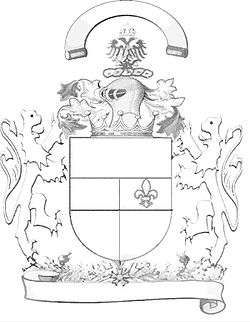Augmentation of honour
| Part of a series on |
| Heraldic achievement |
|---|
| Conventional elements of coats of arms |
|
|
In heraldry, an augmentation (often termed augmentation of honour or sometimes augmentation of arms) is a modification or addition to a coat of arms, typically given by a monarch as either a mere mark of favour, or a reward or recognition for some meritorious act. The grants of entire new coats by monarchs as a reward are not augmentations, but rather grants of arms, and (in theory) an augmentation mistakenly given to someone who did not have a right to a coat would be nugatory.
Augmentations could be of any kind: an ordinary, a charge, or a partition of the field. Most often it involves a chief or a canton, which contains a part or the entirety of the arms of the sovereign, which he concedes to a loyal vassal. Not all modifications to a coat of arms are augmentations of honour. Brisures, for example, are for the cadet lines of the dynasty, which are made by adding a label, bend, bordure, etc.
A common case of augmentations of honour are French cities having in their arms a chief Azure, three fleurs de lys or, also known as the "chief of France", given to cities "faithful" to the king.
In Scotland the most frequent augmentation is the double tressure flory counter-flory, the most recognizable part of the Scottish royal arms, although other cases can be found - for example, Sir Alexander Campbell received an augmentation "a chief argent charged with a rock proper subscribed Gibraltar, between two medals for Seringapatam and Talavera" commemorating his part in the Great Siege of Gibraltar.
Examples
-
.svg.png)
Thomas Howard, 2nd Duke of Norfolk was given an augmentation (shown to the right) to commemorate the Battle of Flodden.[1]
-

Thomas Howard's augmentation, a modified version of the Royal coat of arms of Scotland with an arrow through the lion's mouth.
-

The Duke of Wellington was given an augmentation of the Flag of the United Kingdom in the form of a shield.[1]
-

Some of the Juliusbanner given by pope Julius II to the Swiss cantons and their associates included augmentations or "improvements"; shown here is the banner of Rapperswil, with the two roses of the city's coat of arms rendered in gold instead of the usual red.
- ^ a b Brooke-Little, J.P., FSA (1978) [1950]. Boutell's Heraldry (Revised ed.). London: Frederick Warne LTD. pp. 125–127. ISBN 0-7232-2096-4.
Emperor Charles V, who was also King of Spain, granted to Juan Sebastián Elcano, the surviving commander of the Ferdinand Magellan expedition that first circumnavigated the world, an augmentation of arms consisting of a world globe with the words Primus circumdedisti me (Latin: "You first encircled me"). His grandmother Isabella I of Castille added a pomegranate to her coat of arms in honor of the capture of Granada.

